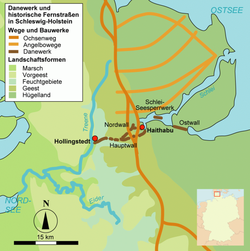Archaeological border complex Haithabu and Danewerk
| Archaeological border complex Haithabu and Danewerk | |
|---|---|
|
UNESCO world heritage |
|

|
|
| Danewerk and Haithabu on the Jutland isthmus between the Baltic Sea and the Treene lowlands |
|
| National territory: |
|
| Type: | Culture |
| Criteria : | (iii) (iv) |
| Surface: | 227.55 ha |
| Buffer zone: | 2670 ha |
| Reference No .: | 1553 |
| UNESCO region : | Europe and North America |
| History of enrollment | |
| Enrollment: | 2018 ( session 42 ) |
The archaeological border complex Haithabu and Danewerk includes the former, medieval Viking sites Haithabu ( Danish Hedeby . Municipality of Busdorf ) and Danewerk (Danish Dannevirke , extends over several municipalities), which in today's districts of Schleswig-Flensburg and Rendsburg-Eckernförde between Hollingstedt ( Treene) and the Windebyer Noor and together are considered to be the most important archaeological ground monuments in Schleswig-Holstein .
Haithabu was an important trading place in the Viking Age . The place was integrated into the border fortifications of the Danewerk, consisting of several earth walls (such as the main and the Easter wall), the Waldemars wall, two ramparts, a lake barrier in the Schlei and a redoubt from the German-Danish War . Both sites are located on the Schleswig and Jutland isthmus .
The history of both sites is presented in the Haithabu and Danewerk museums . Some of the visible remains of the two sites are part of the “ Haithabu-Dannewerk ” nature reserve . The two sites were declared a World Heritage Site by UNESCO on June 30, 2018 .
In the vicinity of Haithabu and the Danewerk there are other archaeological sites such as the former Viking settlement of Füsing and the rune stones of Haithabu .
Exposed Waldemars wall in the archaeological park in the community of Dannewerk
Remains of the Osterwall near Eckernförde
Web links
- Entry on the UNESCO World Heritage Center website ( English and French ).
- World Heritage project office in Haithabu and Danewerk
Individual evidence
- ↑ Haithabu and Danewerk are world cultural heritage. www.ndr.de, June 30, 2018, accessed June 30, 2018 .



